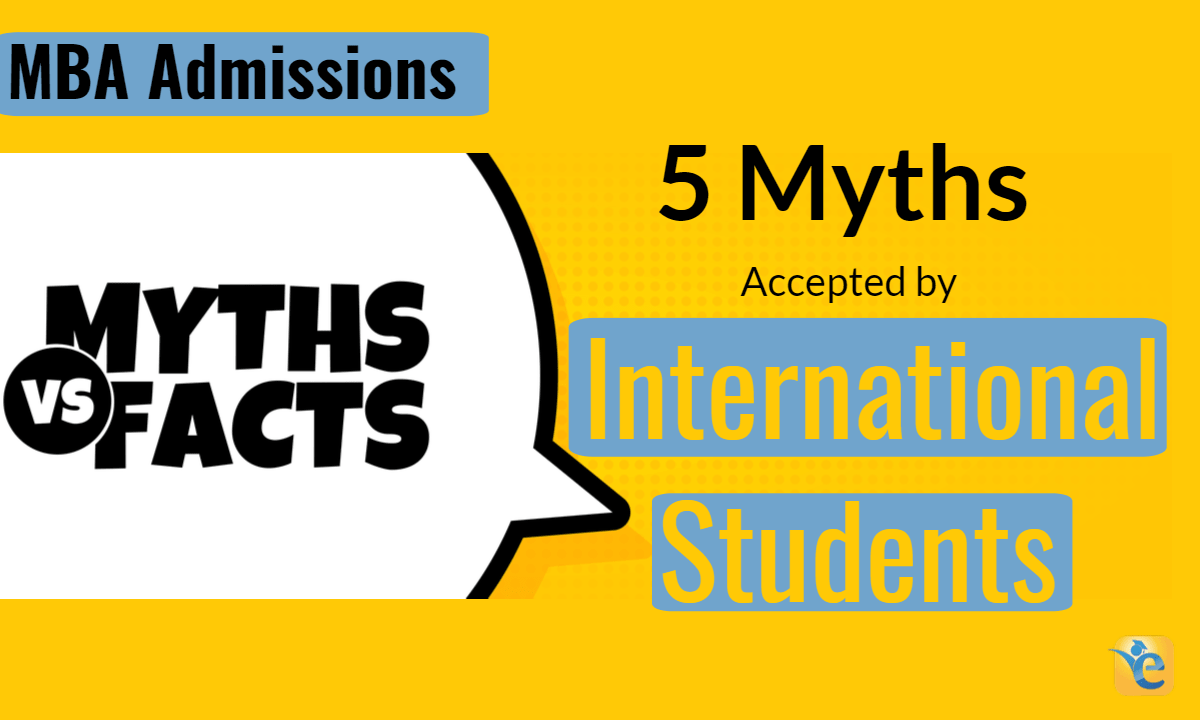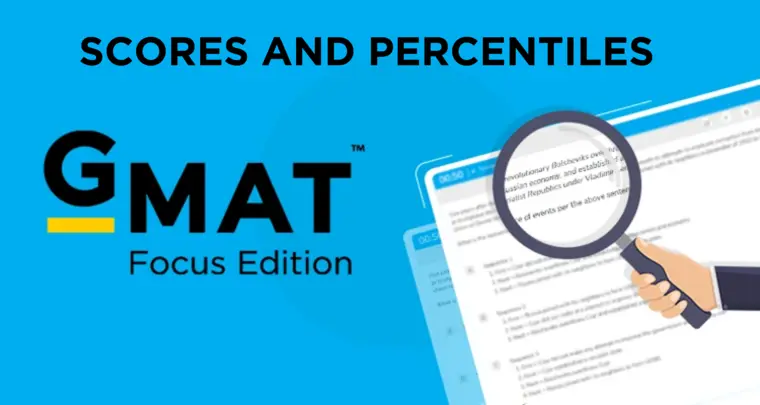Is GMAT 740 the new 700?
International applicants account for over 40% of all applications to top MBA programs in the United States. Yet fewer than 30% of seats in a typical incoming class are reserved for these applicants. The fierce competition among international applicants is compounded by the fact that candidates from just two countries – China and India – accounted for 66% of all GMAT tests taken internationally in 2020 indicating a similarly lopsided ratio in international MBA applications.
With admissions officers at top MBA programs committed to maintaining the diversity of backgrounds in the incoming classes, it is critical for international students to stand out from their peers, especially those coming from over-represented demographics.
A high GMAT score (one that is 20-to-40 points higher than the median GMAT at target schools) is an effective tool, proven to have helped hundreds of international students get admission offers from top MBA programs.
Since 2012, e-GMAT has amassed an alumni base of 100,000+ international students, thousands of whom have received admissions offers from top MBA programs.
In this article, we discuss the statistical trends in admission outcomes for international students based on the outcomes experienced by a sample e-GMAT alumni. We also debunk five common myths accepted by international students when applying to top MBA programs.
The article concludes with a series of best practices that can help international students maximize their chances of admissions at top US B-schools.
- Is GMAT 740 the new 700?
- Introduction to the data-set
- Myth 1: 700 is a “great” target GMAT score
- Myth 2: MBA admissions odds are similar for all applicants.
- Myth 3: Other parts of an MBA application can help offset a low GMAT
- Myth 4: Securing the 20 additional points between 740 and 760 is overkill
- Myth 5: All MBA journeys are the same (and what works for domestic applicants is likely to work for international applicants)
- 5 cases where GMAT score made the difference
- Conclusion
Introduction to the data-set
International candidates with successful admission outcomes in a given admission cycle are the ideal data-points for studying application and acceptance trends for internationals at top business schools globally.
A database of successful e-GMAT alumni is a reasonable data-set for this purpose as it is large, randomized, and unbiased. The majority of the e-GMAT alumni are internationals. Preliminary research was conducted on a database with 446 admits won by 393 unique applicants. These applicants come from diverse backgrounds, in a mix that closely mirrors the application mix received by business schools each year.
Here is the representation of 393 unique applicants by undergraduate degree:
A high GMAT score – one that is 20-to-40 points higher than the median GMAT at target schools – is an effective tool, proven to have helped hundreds of international students get admissions offers from top MBA programs
Professionally, these applicants represent a typical mix of feeder industries such as manufacturing, finance, technology, consulting, and healthcare. Statistical analyses have been conducted on representative samples chosen randomly from this population. Each sample has more than 30 entities, to preserve the confidence and consistency of this research.
Another data source we considered – albeit for qualitative insights – is the repository of 400+ video interviews conducted with successful candidates. You can access their interviews on the e-GMAT YouTube channel. In this research, we aim to look at successful admissions outcomes and understand whether there is a meaningful correlation between a high GMAT score and an admission offer for international students. We also want to study how the acceptance rates at top business schools change as the GMAT score increases. Ultimately, we find out:
- The ideal target GMAT score for an international MBA applicant
- The significance of the GMAT for an international MBA applicant
- The common challenges faced by international applicant
Myth 1: 700 is a "great" target GMAT score
Fact: 740 is the new 700
In this article (updated in 2021), US News stated that - “A GMAT score between 650 and 690 is good. Moreover, a score of 700 or higher is great.” This may be applicable to a very specific applicant pool such as domestic or minority applicants. However, we found evidence to the contrary when it comes to international MBA applicants.
A distribution of GMAT scores for international applicants with admits from top business schools revealed that successful applicants tended to score higher than their domestic counterparts. The typical international MBA at a top program had average GMAT of 728. 28 points higher than what is conventionally considered a “great” GMAT score. Here is the distribution of 351 international MBA candidates by GMAT score:
In order to stand out, a candidate would need to secure a score that is at least one standard deviation above the mean score. This suggests that a good target score for internationals is closer to 740, not 700 as previously thought.
This insight is reinforced when studying the GMAT scores of candidates at M7 schools in the United States. We found that 64% of candidates that received offers from M7 schools scored 740 and above on the GMAT. Here is the visualization of a random selection of 52 MBAs at M7 schools:
While these schools reveal an 80% range of 680 to 760, with a median score of 720 or 730, it seems that the overwhelming majority of international candidates in the class have scores that are towards the top end of the 80% range. Therefore, using the median score at these schools as a guide when considering your target GMAT score may be a bad idea.
We can help you score 740+ on the GMAT. Start your GMAT preparation with the most reviewed GMAT Prep company with more than 2200+ reviews on the GMATClub. Register for our FREE trial and get access to free GMAT resources today!
Myth 2: MBA admissions odds are similar for all applicants.
Fact: Applicants from over-represented demographics face significantly steeper odds.
Our analysis suggests that not only do international applicants face dissimilar admissions odds compared to their domestic counterparts but not all international applications are the same. Applicants from certain parts of the world face seriously challenging odds when applying to their target programs.
As referenced before, Indians and Chinese applicants form the majority of the international MBA applications to the United States. To maintain the diversity, fewer than 14% of the spots are reserved for applicants from both these countries combined. This limited availability makes MBA applications for this group significantly more challenging.
A 2015 research indicates that acceptance rates vary by country. Moreover, candidates from over-represented demographics such as India may face acceptance rates as low as 9% when applying to Top-20 schools in the US.
Here is the Expected vs. Real acceptance rates for international candidates:
| Region | Expected Acceptance Rate | Actual Acceptance Rate | Difference |
| Middle East | 22% | 34% | 12% |
| Europe | 21% | 27% | 6% |
| Latin America | 22% | 28% | 6% |
| United States | 23% | 27% | 4% |
| Canada | 22% | 23% | 0% |
| Average | 23% | 23% | 0% |
| Africa | 23% | 19% | -4% |
| Asia | 24% | 18% | -6% |
| Australia & NZ | 24% | 10% | -14% |
These skewed acceptance rates are the reason candidates need to score higher on the GMAT in order to stand out. An average domestic MBA candidate scored a 700 on the GMAT. But, an average candidate from an over-represented demographic (like India) scored 741.13 to receive admission from a top US B-School.
Here is the median GMAT score for Indian and domestic candidates:
The average score for candidates from over-represented demographics at M7 business schools jumps to 757.39, indicating the existence of outliers with the 99.99th percentile score on the GMAT, most of whom belong to this demographic.
This is not to indicate that a near-perfect GMAT score guarantees an admission offer from an M7 business school. A Booth Ad-com we reached out to states:
“The MBA admissions review is holistic in nature. A score above 760 will do little to tip the scales in your favor,if you come from an over-represented background.”
However, the high mean GMAT for over-represented demographics does signal the abundance of highly qualified candidates with a 760+ GMAT that an international applicant from an over-represented demographic would otherwise need to compete with.
This makes a GMAT 760+ a hygiene factor on the application – it may not massively sway the odds in your favor; however, your application will be hurt in a major way with a sub-760 score.
Myth 3: Other parts of an MBA application can help offset a low GMAT
Fact: The GMAT carries more significance on the MBA application for international applicants.
The MBA application provides the candidate with several avenues to stand out from a pack of similar applicants. MBA application components like GMAT, GPA, essays, extra-curricular, interviews, etc., can be leveraged to make your application stand out. For instance, it is not uncommon for candidates to leverage the essays to attempt to compensate for a lower-than-median GMAT. In fact, this strategy comes recommended by top MBA consultants around the world. However, an analysis of the distribution of scores for international MBAs at Top-20 US schools tells a different story.
Here is the distribution of 121 unique international MBAs at Top-20 US programs based on their GMAT score:
The distribution of GMAT scores for international students resembles a left-tailed distribution (a single-tailed distribution), rather than a normal distribution (a two-tailed distribution). This indicates that the GMAT plays a significant role in the admissions process for an international student, mainly because of the abundance of other similar candidates with competitive GMAT scores.
The data further indicates that 77% of international candidates at top business schools have GMAT scores higher than the median GMAT at that school, further re-enforcing the conclusion that targeting the median GMAT score at your target school is not sufficient – international applicants are expected to score higher.
This is also illustrated in the acceptance rates at M7 schools for otherwise similar candidates but with different GMAT scores. Acceptance rates skyrocketed 61%, from 28% to 45% for candidates with GMAT scores 760 or higher. This reveals an implicit expectation at top schools for international candidates to apply with high GMAT scores. Thus, making it harder for international applicants to justify a low GMAT.
Myth 4: Securing the 20 additional points between 740 and 760 is overkill
Fact: A GMAT 760 significantly increases the odds of admission at M7 schools.
Applicants with a GMAT score of 730 or 740 are often advised to focus on other areas of the MBA application, implying that the marginal effort required to secure the additional 20-30 points and a 760 score is not worth the time investment. As with some other myths, the statistical analysis differs from expert opinion in this case.
When considering a pool of similar applicants, those that scored between 740 and 750 had a 26% chance of securing an admit from an M7 program. This statistic jumped to 34% – a 30% increase – when applying with a 760+ score. Thus, a 3-week effort, typically needed to help a candidate with a GMAT 740 secure a 760, can help improve admissions odds by 30%.
Start your GMAT preparation with the most reviewed GMAT Prep company with more than 2200+ reviews on the GMATClub. Register for our FREE trial and get access to free GMAT resources today!
Myth 5: All MBA journeys are the same (and what works for domestic applicants is likely to work for international applicants)
Fact: International students’ journey to a top MBA is significantly more challenging.
In a 2021 op-ed, US News writer Ilana Kowarski suggests that MBA applicants should aim to spend 100 hours preparing for a standardized test (GMAT or GRE) and another three months working on the applications. Interviews conducted with hundreds of international applicants paint a different picture.
The GMAC estimated that candidates from over-represented demographics spend as many as 500 hours — and multiple attempts – to secure their target GMAT score. A learning platform such as e-GMAT can help candidates secure their target scores in as little as 300 hours – a 40% reduction. But that still implies that most international students need to budget 3x the recommended number of hours to prepare for the GMAT.
Securing a 740+ score is critical as an international applicant given the greater significance assigned to the GMAT on such applications.
In our interview with Ayush Gandhi, Columbia Class of 2021, we discovered that he was waitlisted by Ross School of Business with a 710 score, receiving direct feedback from the admissions director that he needed to increase his GMAT score to put forth a competitive application. After retaking the GMAT and securing a 750 score, Ayush received admits with scholarships from Columbia Business School and Ross School of Business.
5 cases where GMAT score made the difference
- ROSS waitlisted Aayush with GMAT 710. With GMAT 750, ROSS admitted him with scholarships
- Dipinty received waitlists and rejections from ROSS, Darden, and Fuqua, with a GMAT 730. With a 760, she got into TUCK (higher ranked school) with $50K scholarship
- Leonardo Rolim received rejection by MIT, with a GMAT 710 . With GMAT 750, he received admits from Wharton and Booth
- Krishna received rejections from Georgia Tech, ASU, Texas A&M, with a GMAT 680. With a 720, each of these schools offered him a full scholarship
- Because of GMAT 690, Tuck rejected Nishant’s application. With GMAT 740, Nishant got into Columbia with scholarship
After securing a 740+ GMAT score, it is important to spend weeks introspecting and building a compelling applicant story. As an international student, the post-MBA job market is likely to be more challenging for you than your domestic classmates.
So it is important to ensure that your story is plausible and achievable. It is critical to connect with current MBAs at your target school to confirm whether your applicant story is realistic and whether that school can help you achieve your goals.
In our interview with Shaarang Sahanie, Kenan-Flagler Class of 2022, we learned that despite applying with a GMAT 740, he received rejections from 8 top schools because he applied with an unrealistic career story. One that he had failed to confirm with current students at his target schools. After course-correcting in the following application cycle, he was able to secure admits from 4 top business schools with $250,000 in scholarship.
It takes about 10-weeks to work on applying to one school and few more weeks to confirm whether your story is plausible – it is critical to budget for that time.
As an international applicant, rushing the application process could mean having to re-take the GMAT multiple times. In our interview with Mansi Dhiman, Harvard Class of 2020, we learned that starting as much as 24 months early, and meticulously planning each step of the application process may deliver better outcomes.
Mansi understood the need of an elite score on the GMAT to receive admission offers from M7 business schools. So, she carved out a full year to study for the GMAT and secure a 770 score. Then, she tackled the less-open ended applications in Wharton and Kellogg before starting work on the more challenging ones in Harvard and Stanford. With the end of the 2017/2018 application cycle, a full 24 months after Mansi first started working towards her applications, Mansi received admission offers from Harvard, Stanford, Wharton, and INSEAD – the very best MBA programs in the world.
Conclusion
International applicants compete for fewer seats and those from over-represented demographics compete for fewer still. Top MBA programs expect their international applicants to apply with a higher-than-median GMAT score. To present a competitive application, it is critical to apply with a 740+ GMAT score. While a high GMAT score will not guarantee admission, or even an interview call, applying with a lower GMAT can significantly weaken your application.
Further, a 760+ score may significantly improve your chances of securing an admit from an M7 school, so the additional 3-week time investment required to achieve a truly elite score is worth the effort.
Start your GMAT preparation with the most reviewed GMAT Prep company with more than 2200+ reviews on the GMATClub. Register for our FREE trial and get access to free GMAT resources today!















